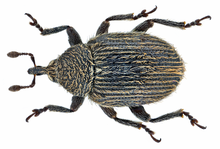Rhinusa antirrhini
| Rhinusa antirrhini | ||||||||||||
|---|---|---|---|---|---|---|---|---|---|---|---|---|

Rhinusa antirrhini |
||||||||||||
| Systematics | ||||||||||||
|
||||||||||||
| Scientific name | ||||||||||||
| Rhinusa antirrhini | ||||||||||||
| ( Paykull , 1800) |
Rhinusa antirrhini is aspecies of beetle in the family of weevils .
features
The beetles have an oval-shaped black body. The pronotum is narrowed on the sides with an even, conically rounded shape. Rows of fine yellow-brown hairs run over the body. Within the species, a distinction is made between beetles with a preference for the Dalmatian toadflax ( Linaria genistifolia dalmatica ; in English "Dalmatian toadflex") and beetles with a preference for the gorse toadflax ( Linaria genistifolia ; in English "narrow-leaved Dalmatian toadflax"). The former reach a body length of 5 mm, while the beetles of the second group are only 3 mm long.
distribution
The species is widespread in Europe. The species is common in Central Europe. Their occurrence ranges from Scandinavia, the Baltic States and Great Britain in the north to the Mediterranean and North Africa (Algeria) in the south and the Caucasus in the east. In North America the species was introduced in the middle of the 20th century. In the meantime, it is used in certain places for biological pest control against the introduced Dalmatian toadflax.
Way of life
To the host and food plants of Rhinusa antirrhini include various linaria , in particular the real Leinkraut ( Linaria vulgaris ), the broom-Leinkraut ( Linaria genistifolia ) and the strip-Leinkraut ( Linaria repens ) and Linaria saxatilis . Other host plants are the snapdragon ( Antirrhinum ), the toadflax ( Chaenorhinum minus ) and various figwort plants (Scrophulariaceae). The adults hibernate. From May they appear on their host plants. Eggs are usually laid between June and August. The eggs are laid in the fruit capsules of the plants, where the hatched larvae then develop. The new generation of adult beetles appears in August and September.
Taxonomy
The following synonyms can be found in the literature :
- Curculio antirrhini Paykull , 1800
- Gymnetron antirrhini ( Paykull , 1800)
Web links
Individual evidence
- ↑ a b c d e f Arved Lompe: Rhinusa - determination table . coleonet.de. Retrieved December 22, 2018.
- ↑ a b c d e f g h i Rhinusa antirrhini (Paykull) . Ministry of Forests, Lands and Natural Resource Operations, British Columbia. Retrieved December 22, 2018.
- ↑ a b Rhinusa antirrhini in Fauna Europaea. Retrieved December 22, 2018
- ↑ a b Species Rhinusa antirrhini - Toadflax Seedhead Weevil . bugguide.net. Retrieved December 22, 2018.
- ↑ Rhinusa antirrhini . www.biolib.cz. Retrieved December 22, 2018.
